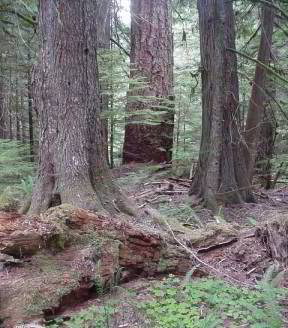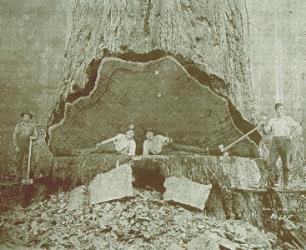Oregon

Old Growth in Willamette State Forest - photo US Forest Service
 Oregon
Oregon
On March 14, 2010 the Eastern Native Tree
Society and Western Native Tree Society switched from discussion lists
on Google Groups to a new discussion list in a Bulletin Board format at:
http://www.ents-bbs.org/index.php Posts made since the inception
of the BBS on March 14, 2010 will be sorted and archived on the BBS.
Click on the link to go to the equivalent section on the new BBS. This
website will continue to serve as a front end for the ENTS and WNTS
groups. It will continue to serve as a repository of older posts, and
will serve as the host site for special projects and features that are
not well suited for a BBS format. Please visit the BBS for the latest
information and trip reports.
General Discussions
-
The precious gifts beneath Oregon's trees
The precious gifts beneath Oregon's trees By The
Oregonian Editorial Board December 25, 2009, 7:13AM ....Look outside:
There's new wilderness, new hope for the shallow and sick Klamath River
and new impetus for an agreement to restore forests and badly needed
sawmill jobs in Oregon's rural eastside communities. The 202,000 acres
of new Oregon wilderness signed into law by President Obama in March is
a gift that will endure forever in Oregon. The new wilderness -- the
first in Oregon in 25 years -- at Mount Hood, the Columbia Gorge, Copper
Salmon, Soda Mountain, Spring Basin and the Badlands near Bend will
provide lasting protection to some of Oregon's most beautiful and
precious places...
December 29, 2009
-
Mind in the Forest WNTS,
ENTS, There is an interesting article posted on this website:
[link] Mind in the Forest An intimate encounter with really old
trees by Scott Russell Sanders Published in the November/December 2009
issue of Orion magazine THE SETTING OF THIS ESSAY by Scott Russell
Sanders is the H. J. Andrews Experimental Forest, a 15,800-acre research
area in the Cascade Mountains of Oregon. Research conducted at the
Andrews Forest has taught us much of what we know about old-growth in
the Pacific Northwest......
more » Oct 30, 2009.
-
Pacific Coast Old Growth August 29,
2009
- Are the Timber Wars in
the West Over June 22, 2009
- Oregon Caves
National Monument, OR June 28, 2009
- Proposed Oregon Restoration and Old
Growth Protection Act
http://groups.google.com/group/entstrees/browse_thread/thread/6ad8f30d19fcc979?hl=en
- What is the
largest known Atlas Cedar? Feb 2009
- Admiring a
Great Pine in Oregon July 2003
- Kloochy Creek
Giant Falls Dec 2007
- Ascending the
Giants, OR April 2008
 Oregon Register
of Big Trees http://www.odf.state.or.us/DIVISIONS/resource_policy/resource_planning/Big_Tree/
bigtrees.asp?id=401010205 tate and National Champion Trees Located in Oregon. This database has been updated to include state and national champions through 2002. Each of the trees listed below has an individual record, which you can access by clicking on the tree's common name. This record describes the tree's measurements, who nominated it and where it is located. Oregon Register
of Big Trees http://www.odf.state.or.us/DIVISIONS/resource_policy/resource_planning/Big_Tree/
bigtrees.asp?id=401010205 tate and National Champion Trees Located in Oregon. This database has been updated to include state and national champions through 2002. Each of the trees listed below has an individual record, which you can access by clicking on the tree's common name. This record describes the tree's measurements, who nominated it and where it is located.
 22 foot diameter Douglas Fir? Deer
Island, Oregon 22 foot diameter Douglas Fir? Deer
Island, Oregon
 Douglas Fir at Deer Island, Columbia County, Oregon
http://www.vannattabros.com/histlog18.html Douglas Fir at Deer Island, Columbia County, Oregon
http://www.vannattabros.com/histlog18.html
 Crater Lake
National Park http://www.nps.gov/crla/
Crater Lake is widely known for its intense blue
color and spectacular views. During summer, visitors may navigate the
Rim Drive around the lake, enjoy boat tours on the lake surface, stay in
the historic Crater Lake Lodge, camp at Mazama Village, or hike some of
the park's various trails including Mt. Scott at 8,929 ft. Diverse
interpretive programs enhance visitors' knowledge and appreciation of
this national park, 90% of which is managed as wilderness. The winter
brings some of the heaviest snowfall in the country, averaging 533
inches per year. Crater Lake
National Park http://www.nps.gov/crla/
Crater Lake is widely known for its intense blue
color and spectacular views. During summer, visitors may navigate the
Rim Drive around the lake, enjoy boat tours on the lake surface, stay in
the historic Crater Lake Lodge, camp at Mazama Village, or hike some of
the park's various trails including Mt. Scott at 8,929 ft. Diverse
interpretive programs enhance visitors' knowledge and appreciation of
this national park, 90% of which is managed as wilderness. The winter
brings some of the heaviest snowfall in the country, averaging 533
inches per year.
 Willamette National Forest
http://www.fs.fed.us/r6/willamette/
The Willamette National Forest has eight wildernesses which total 380,805 acres. These areas, the majority of which encompass seven major mountain peaks in the Cascades, are popular with hikers, backpackers, and mountain climbers. Maps are available for these areas. Willamette National Forest
http://www.fs.fed.us/r6/willamette/
The Willamette National Forest has eight wildernesses which total 380,805 acres. These areas, the majority of which encompass seven major mountain peaks in the Cascades, are popular with hikers, backpackers, and mountain climbers. Maps are available for these areas.
 Willamette NF - Old
Growth on the Middle Fork Ranger District http://www.fs.fed.us/r6/willamette/forest/oldgrowth/index.html
There are four basic forest types on the Middle Fork district,
Douglas-fir dominated (with some western hemlock and western redcedar),
mixed conifer (which contains Douglas-fir, grand fir, sugar pine,
incense cedar, and ponderosa pine), Pacific silver fir, and mountain
hemlock. These are general categories; all tree species often
occur as minor components in other types. In response to the interest in old growth forests, the 1990 Willamette National Forest Land and Resource Management Plan designated a number of old growth groves (see Table 1). These stands are representative examples of old growth forest types which are especially scenic and easily assessable to the public, either by being adjacent to main roads, or accessed by a short and easy hiking trail. Fourteen old growth groves have been designated on the Middle Fork district, totaling about 2000 acres.
Willamette NF - Old
Growth on the Middle Fork Ranger District http://www.fs.fed.us/r6/willamette/forest/oldgrowth/index.html
There are four basic forest types on the Middle Fork district,
Douglas-fir dominated (with some western hemlock and western redcedar),
mixed conifer (which contains Douglas-fir, grand fir, sugar pine,
incense cedar, and ponderosa pine), Pacific silver fir, and mountain
hemlock. These are general categories; all tree species often
occur as minor components in other types. In response to the interest in old growth forests, the 1990 Willamette National Forest Land and Resource Management Plan designated a number of old growth groves (see Table 1). These stands are representative examples of old growth forest types which are especially scenic and easily assessable to the public, either by being adjacent to main roads, or accessed by a short and easy hiking trail. Fourteen old growth groves have been designated on the Middle Fork district, totaling about 2000 acres.
Table 1 ~ Designated Old Growth Groves on the Middle Fork District
| Grove Name |
Dominant species |
Significant
attribute |
| Big Swamp |
Douglas-fir, W. redcedar |
Tree diameter |
| Cayuse Creek |
Douglas-fir, True fir |
Tree diameter |
| Elk Camp |
Douglas-fir, True fir |
Outstanding example |
| Fall Creek |
Douglas-fir |
Tree diameter |
| Fisher Creek |
Douglas-fir |
Tree diameter |
| Gold Lake |
Douglas-fir, Mt. Hemlock |
Outstanding example |
| Kelsey Creek |
Douglas-fir |
Tree diameter, Age |
| Little Fall Creek I |
Douglas-fir |
Tree diameter, Height |
| Little Fall Creek II |
Douglas-fir |
Tree diameter, Height |
| Sardine Butte |
Douglas-fir, True fir |
Tree diameter, Age |
| Upper Furnish Creek |
Douglas-fir, True fir |
Stage diversity |
| Upper Salmon Creek |
Douglas-fir |
Park-like stand |
| Wall Creek |
Douglas-fir, W. redcedar |
Accessibility |
 Opal Creek, Willamette National Forest, Oregon
http://gorp.away.com/gorp/activity/wildlife/topten_oldgrowth3.htm
Opal Creek is not far from Portland, Oregon, deep in the heart of Douglas fir country."Doug" fir is the predominate species of the Pacific Northwest. They create multilayered canopies and an eventful forest floor with many fallen logs and "snags," which are standing dead trees. In the 1980s, Opal Creek was the object of a fierce campaign to save it. Out of that struggle grew an innovative program to maintain the forest and educate the public about the value of ancient forests. The Friends of Opal Creek maintain an education center at an old camp called Jawbones Flats, in the Detroit Ranger District of Willamette National Forest. Opal Creek, Willamette National Forest, Oregon
http://gorp.away.com/gorp/activity/wildlife/topten_oldgrowth3.htm
Opal Creek is not far from Portland, Oregon, deep in the heart of Douglas fir country."Doug" fir is the predominate species of the Pacific Northwest. They create multilayered canopies and an eventful forest floor with many fallen logs and "snags," which are standing dead trees. In the 1980s, Opal Creek was the object of a fierce campaign to save it. Out of that struggle grew an innovative program to maintain the forest and educate the public about the value of ancient forests. The Friends of Opal Creek maintain an education center at an old camp called Jawbones Flats, in the Detroit Ranger District of Willamette National Forest.
 Visit Old Growth.com http://www.visitoldgrowth.com/Amount.htm
Old Growth Forests in Oregon: Total old
growth forests in
Oregon
State
total 4,905,544 acres according to the United States Department of
Agriculture in Publication PNW-RB-197. The publication lists
50,480 acres in
Oregon
’s National Parks, 4,335,957 acres in
Oregon
’s National Forests, and 9,550 acres in
Oregon’s State Parks.
Visit Old Growth.com http://www.visitoldgrowth.com/Amount.htm
Old Growth Forests in Oregon: Total old
growth forests in
Oregon
State
total 4,905,544 acres according to the United States Department of
Agriculture in Publication PNW-RB-197. The publication lists
50,480 acres in
Oregon
’s National Parks, 4,335,957 acres in
Oregon
’s National Forests, and 9,550 acres in
Oregon’s State Parks.
 GORP - Oregon
Wilderness Areas http://gorp.away.com/gorp/resource/us_wilderness_area/or.htm Badger Creek, Black Canyon, Boulder Creek, Bridge Creek, Bull of the Woods, Columbia, Cummins Creek, Diamond Peak, Drift Creek, Eagle Cap,
Gearhart Mountain, Grassy Knob, Hells Canyon, Kalmiopsis, Menagerie, Middle
Santiam, Mill Creek, Monument Rock, Mountain Lakes, Mount Hood, Mount Jefferson, Mt. Thielsen, Mt. Washington, North Fork John Day, North Fork Umatilla, Olallie, Red Buttes, Rock Creek, Rogue-Umpqua Divide, Salmon Huckleberry, Sky Lakes, Steens Mountain,
Strawberry Mountain, Table Rocks, Three Arch Rocks, Three Sisters, Waldo Lake, Wenaha-Tucannon, Wild Rogue. GORP - Oregon
Wilderness Areas http://gorp.away.com/gorp/resource/us_wilderness_area/or.htm Badger Creek, Black Canyon, Boulder Creek, Bridge Creek, Bull of the Woods, Columbia, Cummins Creek, Diamond Peak, Drift Creek, Eagle Cap,
Gearhart Mountain, Grassy Knob, Hells Canyon, Kalmiopsis, Menagerie, Middle
Santiam, Mill Creek, Monument Rock, Mountain Lakes, Mount Hood, Mount Jefferson, Mt. Thielsen, Mt. Washington, North Fork John Day, North Fork Umatilla, Olallie, Red Buttes, Rock Creek, Rogue-Umpqua Divide, Salmon Huckleberry, Sky Lakes, Steens Mountain,
Strawberry Mountain, Table Rocks, Three Arch Rocks, Three Sisters, Waldo Lake, Wenaha-Tucannon, Wild Rogue.
|

 22 foot diameter Douglas Fir? Deer
Island, Oregon
22 foot diameter Douglas Fir? Deer
Island, Oregon